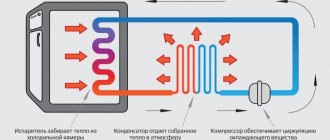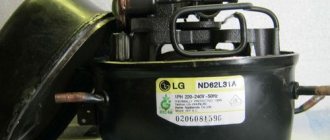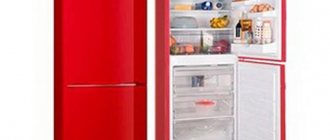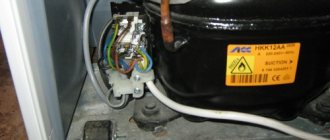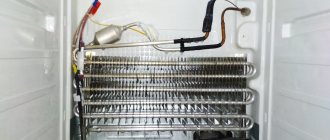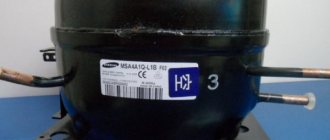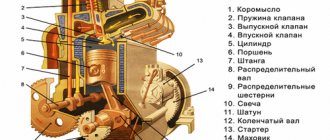The refrigerator has long been part of the everyday life of modern people and few people can imagine life without it. Normal nutrition with fresh and high-quality products depends on the condition of this most important piece of household appliances.
High-quality freezing and cooling of food, maintaining a constant cool temperature to preserve food freshness, sealing doors - all this affects the condition of food.
How we carry out repairs
Make a request by phone or through the form
The master arrives in 60 minutes
We diagnose the device
We coordinate and carry out the necessary work
Accept working equipment and pay for the order
Possible causes of heat in the refrigerator
- The door seal is broken. The soft magnetic material that provides the seal can become damaged - it can dry out, become warped, or be damaged by pets. In this case, it is enough to replace this material with a new one.
- Fan icing. This is the most common reason. The refrigerator requires periodic defrosting to function properly.
- Large difference between external and internal temperatures. If it is very hot outside, this does not mean that you need to set the same strong cooling, the usual temperature is enough. In addition, the refrigerator compressor may fail due to overvoltage.
- Recent defrost. After this procedure, the motor will generate cold, so the walls of the refrigerator will be warm. Therefore, after defrosting, you do not need to immediately load food into the refrigerator; let it sit empty for at least 1 hour.
- There is too much food in the refrigerator. The motor may not cope with the task, if there is a large volume of products in the chamber, it is better to place them there in batches.
- Warm food in the refrigerator. It is highly not recommended to put anything warm in the refrigerator.
Main heat sources
- Capacitor. This is a heat exchanger that can be located in the rear, in the side walls or at the bottom. The most common option is a heat exchanger in the form of a coil on the rear wall. It is installed not only in Russian-made refrigerators, but also in imported Kuppersbusch models. If the condenser is located in the side walls, then heat may be felt from them. If the walls are heated frequently, this particular unit should be checked first.
- Compressor. During operation, the motor gets very hot, especially under load. This can be felt by touching the motor itself or the back wall. To avoid this, it is recommended to monitor the temperature conditions inside the Kuppersbusch refrigerator - in particular, the position of the regulator. It is also advisable to clean the compressor from dust and contaminants that impede heat transfer.
Eliminating heat in the refrigerator yourself
In most of the cases described above, you can eliminate the cause of heat in the refrigerator yourself - just remove the cause of poor heat transfer. There are reasons that cannot be immediately detected - for example, a blockage in the capillary system. In this case, you can try to remove the blockage by tapping.
Also, do not forget about the prevention of such breakdowns - do not place the refrigerator next to heating devices and close to the wall, so as not to disturb the heat exchange. If the breakdown is serious, then it is better to contact a specialist, because... Fixing such problems yourself may lead to an even worse problem.
Why does the refrigerator compressor get hot?
One of the main parts of the refrigerator is the compressor, which ensures constant circulation of refrigerant (freon) in the system. If this part fails, the refrigerator will also stop working. Therefore, it is important to check the temperature of the compressor from time to time, since excessive heating is a clear indication that there is some problem with the system.
Next, let's look at the reasons why the refrigerator compressor gets hot. Let's briefly look at the technical principles of the cooling system and tell you whether it is possible to repair the compressor yourself. First things first.
Important! Repairing the compressor yourself or dismantling it will affect the cost of future repairs at the service center. If you do not have the appropriate knowledge and experience in repairing such equipment, it is better to immediately call a specialist at home https://tiptop-servis.ru/remont-holodilnikov/.
Cost of removing heat from refrigerator
| Name of works | Price |
| A technician will visit your home in the city | from 0 rub |
| Diagnosis of faults during subsequent repairs | from 0 rub |
| Doesn’t freeze, doesn’t cool, doesn’t turn on, doesn’t turn off, gives an error, beeps | |
| Refrigerant leak, microcracks in the gas system | from 630 RUR |
| Failure of the motor-compressor | from 1450 rub. |
| Gas system capillary tube clogged | from 850 rub. |
| Gas system dryer filter clogged | from 350 rub. |
| Solenoid valve failure | from 730 RUR |
| Damage to the thermostat or temperature sensor | from 830 RUR |
| Breakdown of the start-protection relay | from 370 rub. |
| No Frost system malfunction | from 530 rub. |
| Control module is faulty | from 950 rub. |
| Very cold, freezing | |
| Failure of the motor-compressor | from 1450 rub. |
| Solenoid valve failure | from 730 RUR |
| Damage to the thermostat or temperature sensor | from 830 RUR |
| No Frost system malfunction | from 530 rub. |
| Control module is faulty | from 950 rub. |
| Ice or snow coat inside | |
| Refrigerant leak, microcracks in the system | from 630 RUR |
| Failure of the motor-compressor | from 1450 rub. |
| Gas system capillary tube clogged | from 850 rub. |
| Gas system dryer filter clogged | from 350 rub. |
| Solenoid valve failure | from 730 RUR |
| Damage to the thermostat or temperature sensor | from 830 RUR |
| Increased noise, rattles, buzzes | |
| Damage or failure of the fan | from 450 rub |
| Failure of the motor-compressor | from 1450 rub. |
| No Frost system malfunction | from 530 rub. |
| Water inside or outside | |
| Possible overflow of the tray, its damage | from 250 rub. |
| Drainage system for draining melt water | from 350 rub. |
| No Frost system malfunction | from 530 rub. |
| Possible breakdowns in the gas system | from 450 rub |
| Additional services | |
| Repairing or replacing the hinge of a built-in refrigerator | from 630 RUR |
| Refrigerator prevention | from 370 rub. |
| Overhaul of the refrigerator gas system | from RUB 2,630 |
| Overhaul - restoration repair of the electrical or electronic system of the refrigerator | from 1,980 rub. |
| Replacing the combined gas system with a copper one. Warranty of 10 (ten) years! | RUB 14,999 |
Prices are indicated only for work; the cost of the replacement part will be announced by the technician after diagnosis, specifying the exact price of the original spare part immediately over the phone. The price of the work may vary depending on the complexity of the installation and the model of your washing machine. After agreeing on the price, the master begins the repair. Upon completion of the repair, the master leaves a guarantee on his work. If you refuse repairs, you only pay 500 rubles for diagnostics.
The main reasons for the refrigerator to heat up after defrosting
It is not always worth contacting a repair service if the refrigerator is hot after defrosting. First you need to understand the reasons for the heating.
The door is open for a long time (or problems with the seal)
When the door is open, the compressor begins to work hard to maintain a low temperature inside the chamber. This explains why the refrigerator gets warm after defrosting. If the device continues to operate in this mode for several hours, then noise and vibration appear - signs of compressor failure.
A worn seal rubber is another reason for the cooling system to run continuously. Warm air enters the freezer through the resulting cracks. Energy resources are wasted, food spoils quickly.
If the rubber band is intact, but after defrosting the refrigerator the seal heats up, then there is no need to worry. Along the perimeter of the door of many modern models there is a heating circuit that prevents the formation of condensation in the freezer compartment.
Faulty thermostat
The thermostat controls the temperature in the chamber by controlling the compressor to turn on and off to maintain the desired degree of cooling. Its malfunction is the reason for the unit’s malfunction, which explains why, after defrosting, the refrigerator heats up, turns off spontaneously, or begins to freeze too much.
The refrigerator is in the wrong place
To protect the device from overheating and damage, you need to choose the right installation location:
- The unit should not be placed near heating appliances, microwave ovens, stoves, bread makers and other household appliances that actively generate heat during operation.
- It is not recommended to place the refrigerator close to the wall or at a distance of less than 10 cm. For many models, the condenser grille is located outside.
- The device must be level. When tilted, the door may not close tightly enough.
The choice of location is the main component of the long service life of the device, which cannot be neglected.
Warm products
Hot products increase the workload of the compressor, which is struggling with the increase in temperature inside the chamber. Steam from food can settle on the cooling systems in the form of an ice coat, which will cause the device to wear out until it completely fails.
Thermostat failure
The thermostat, like the thermostat, is responsible for maintaining the desired temperature inside the chamber by turning the compressor on and off. This is a completely independent device, which may include a heat regulator.
A malfunctioning thermostat causes the refrigerator to overheat, which can be felt by touching the refrigerator body.
Gas leak (freon)
Freon leakage disrupts the thermal balance, causing the compressor to start working continuously. The cause of a substance leak may be as follows:
- mechanical damage to the tubes (manual removal of ice from the walls of the chamber, improper transportation of the refrigerator);
- material aging, corrosion;
- manufacturing defect.
If the condenser grille is cold and the temperature in the refrigerator does not drop to the required level, then the cause of overheating lies in a freon leak.
Operating principle of the compressor and cooling system
The operation of the cooling system is based on the unique properties of freon (also known as refrigerant) - a gas that, depending on pressure and temperature, can transform from one state of aggregation to another. To put it simply, under pressure freon turns from gas into liquid and vice versa.
How does the cooling system work? The compressor pumps freon vapor, causing the pressure to increase, followed by the temperature (up to 50-70 °C). The refrigerant under pressure rises into the condenser (the grill at the back of the refrigerator), where it gradually cools and turns into a liquid state. Afterwards, the liquid freon enters the capillary tube, then into the evaporator, where it “boils”, taking heat from the freezer and the inside of the refrigerator, simultaneously passing back into a gaseous state. That's it in a nutshell.
The compressor operates periodically, that is, it turns on and off. This maintains a constant temperature inside the refrigerator and freezer. During operation, the compressor heats up, but not more than 70 °C (limit – 90 °C). If the temperature is higher, this is a clear sign of a malfunction.
Signs of compressor failure
Since few people regularly check the temperature of the compressor, problems in its operation are calculated by indirect signs. For example:
- in addition to the increased temperature, ice formation is observed on the walls of the refrigeration chamber;
- the temperature regime inside the refrigerator is disrupted (insufficient cooling);
- possible current breakdowns on the compressor housing (if you touch it, it can give you a slight electric shock);
- The device motor does not start.
If there is one of the indirect signs, check the temperature of the compressor to make sure that it is the cause of the malfunction.
Reasons why the refrigerator compressor gets hot
Excessive heating of the compressor is the result of its continuous operation. Under normal conditions, it turns on and off periodically, which regulates its temperature. If the compressor runs continuously for a long time, the temperature rises above 90 °C.
Reasons for continuous operation of the compressor:
- The seal on the refrigerator door is worn out. Over time, the seal dries out, small gaps form through which warm air enters the refrigerator, forcing the compressor to work continuously.
- The temperature sensor has failed. Incorrect temperature sensor readings cause the cooling system to work without stopping.
- Blockage in the capillary tube. The cause of the blockage is oil, which disrupts the uniform circulation of freon in the system.
- Refrigerant leakage is the most common problem.
Important! When you turn on the refrigerator for the first time, the cooling system will work non-stop for about 2 hours. This is normal, but only after the first launch.
Is it possible to repair the compressor yourself?
Unfortunately no. If you can somehow replace the light bulb in the refrigerator yourself, repairing the compressor is a task that only an experienced technician can handle. The maximum you can do is try to identify the breakdown through direct or indirect signs, and call the service center, explaining in detail to the technician the essence of the problem. This will help speed up the repair of your refrigerator.
Source


